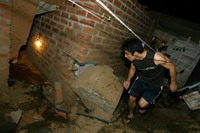Death toll in earthquake in Peru rises
Rescue teams tried across a shattered countryside on Thursday to reach victims of a powerful earthquake that took at least 337 lives and injured 827 people. The Red Cross expects the death toll is likely to rise.

The government rushed police, soldiers, doctors and aid to Ica, a city of 120,000 believed to be near the center of damage, but traffic to the area was paralyzed by giant cracks and fallen powerlines on the Pan American Highway south of Lima. Large boulders also blocked Peru's Central Highway to the Andes mountains.
In Chincha, a small town 90 miles (145 kilometers) southeast of Lima, an AP journalist counted 30 bodies under bloody sheets on the floor of the badly damaged hospital.
In nearby Pisco, "the dead are scattered by the dozens on the streets" and at least 200 people were buried under the rubble of a collapsed church, said Juan Mendoza, mayor of Pisco, in an interview with Lima radio station CPN.
"We don't have lights, water, communications. Most houses have fallen, churches, stores, hotels, everything is destroyed," Mendoza said, sobbing.
Civil Defense Commander Aristides Mussio, appearing on state television, said one person was killed in Lima and 336 in the region of Ica.
But Giorgio Ferrario, Peru chief for the International Federation of the Red Cross, told CNN he believed "that the death toll will rise again now that the night is over ... so that the rescue teams will be able to make the work more properly."
He said it had taken Red Cross workers 7 1/2 hours to reach Ica because "the road is destroyed." Two Red Cross planes were being flown in from Panama with tents, blankets and other aid, but with the condition of Pisco's airstrip unknown, it wasn't clear how or when they would arrive.
Communications with the region were complicated by telephone outages and electricity blackouts.
Local news media reported that people were crowding quake-damaged hospitals in Ica.
The U.S. Geological Survey said Wednesday's magnitude 7.9 earthquake hit at 6:40 p.m. (2340 GMT) about 90 miles (145 kilometers) southeast of Lima at a depth of about 25 miles (40 kilometers). At least four strong aftershocks ranging from magnitudes of 5.4 to 5.9 were felt afterward.
Some homes collapsed in the center of Lima, where thousands fled into the streets for safety. The quake held the capital in its grip and shook it furiously for more than two minutes, longer than any time in recent memory in the quake-prone Andean region.
"This is the strongest earthquake I've ever felt," said Maria Pilar Mena, 47, a sandwich vendor in Lima. "When the quake struck, I thought it would never end."
Antony Falconi, 27, desperately tried to find a way home in the crowded streets, flagging down buses in the dark.
"Who isn't going to be frightened?" Falconi said. "The earth moved differently this time. It made waves and the earth was like jelly."
Firefighters put out a fire in a shopping center, and state doctors striking for higher pay called it off to help out.
President Alan Garcia said public schools would be closed until the safety of their buildings could be confirmed.
The last time such a large quake struck Peru was in September 2005, when a 7.5 magnitude earthquake killed just four people in the sparsely populated northern jungle. In 2001, a 7.9-magnitude quake near the southern city of Arequipa killed 71.
The region sits on two plates that are constantly shifting and Thursday's earthquake, like most earthquakes in the area, occurred when one plate dove under the other quickly, according to Amy Vaughan, a USGS geophysicist at the National Earthquake Information Center in Golden, Colo.
The plates are always "moving slowly, but this was a sudden shift," Vaughan said.
Some of the world's biggest quakes, including the catastrophic Indian Ocean temblor in 2004 that generated deadly tsunami waves, are caused by a similar movement of plates.
Subscribe to Pravda.Ru Telegram channel, Facebook, RSS!


